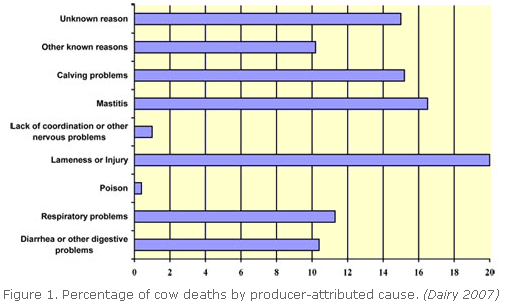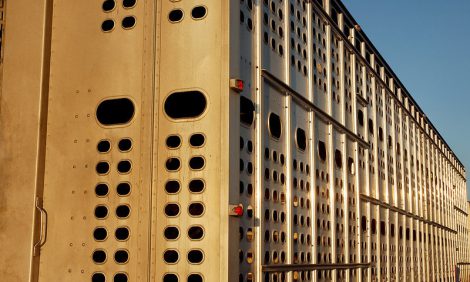



Dairy Cow Mortality: A Growing Problem
The Dairy 2007 USDA survey reported that 5.7% of cows died on-farm across the country in 2006, writes Marcia Endres, Extension Dairy Scientist, University of Mississippi.That is an increase from 4.8% in the 2002 survey and 3.8% in the 1996 survey. Frank Garry from Colorado State University reported that DHIA Provo-recorded dairy cattle death rates in 8 Western states increased from 3% in 1992 to 10% in 2002. These high death rates in dairy cows are very concerning. Annual death rates for beef cows and feedlot cattle are estimated at 1 to 1.5%. Yes, they are managed very differently, but they belong to the same animal species as dairy cows. Besides being an economic issue (replacing dead cows costs money), this is also an indication of an animal welfare problem.

The Dairy 2007 USDA survey (Figure 1) indicates that the single largest cause of cow death as reported by producers was lameness or injury (20%), followed by mastitis (16.5%), calving problems (15.2%), and unknown reasons (15%).
Recent studies presented at the 2008 Annual American Dairy Science Association meetings or published in the Journal of Dairy Science investigated risk factors associated with dairy cow mortality in the United States. Penn State University researchers summarized the association of mortality and 60-day culling rates with various housing and management systems. Mortality rate was lower in tiestall herds (3.3%) than in freestall herds (4.9%). The most optimal herd environment in their study – tiestall, component feeding, with pasture access – had mortality rate of 2.1% and 60-day culling rate of 5.3%; whereas, the least optimal environment – freestall, use of TMR, no outdoor access – had 6.3% and 9.1%, respectively.
University of Tennessee researchers found that smaller herd size (<100 or 100 to 200) was associated with lower mortality risk, except that Holstein herd sizes of 200 to 700 had higher mortality risk than herds with more than 700 cows. In Holstein herds, herd expansion of less than 30% had higher mortality risk than herds that expanded more than 350%. Intermediate scale expansion was associated with increased risk of mortality in Holstein herds but decreased risk of mortality in Jersey herds (compared to >200%). It seems that either small or large was better than intermediate herd size.
Colorado State University researchers looked at various management practices or characteristics of 953 dairy operations across the country and published their results in the Journal of Dairy Science (2008, 91:1423-1432). Eighty of the 119 factors they investigated had some association with mortality and were further explored in a more complex statistical model. Some of the factors that were associated with greater mortality included herd size (larger than 355 cows), milk production level (greater than 22,000 lbs rolling herd average), and fresh cow management (routine drenching of fresh cows). Reproductive problems such as greater levels of abortion, retained placenta, difficult calving, and metritis were all associated with increased mortality rate. Other health issues associated with higher mortality included respiratory problems, lameness, diarrhea, displaced abomasum, and clinical mastitis. In addition, use of freestalls as the primary housing facility, feeding a TMR, and using a multiple animal area for maternity were associated with greater mortality.
After running the more complex statistical model, they found that herd levels of respiratory disease, lameness, antibiotic use for treating sick cows, percentage of cows culled less than 50 days in milk, average calving interval, use of TMR, and region of the country were the factors more significantly associated with mortality. Herds located in western, Midwestern, and southeastern regions had increased odds of a greater level of mortality than herds in northeastern United States. Herds with a high percentage (>3.4%) of respiratory problems were 2.75 times more likely to have a greater level of mortality compared with herds with no documented respiratory problems. Herds with high percentage of lameness (>16.1%) were 2.89 times more likely to have higher mortality than herds with low levels of lameness (<3.3%).
Authors suggested that the more intensive management practices of crowding and feeding high levels of concentrate, and changes in the physical and social environment that contribute to less individual attention per cow combined with lack of dairy personnel training and experience to identify early stages of disease and apply timely and appropriate treatment could all contribute to the loss of animals on the farm.
Regarding a cow as an individual rather than only focusing on groups could help reduce some of the problems leading to high mortality in our dairy operations. Look at and see each animal, and treat them early.
October 2008



